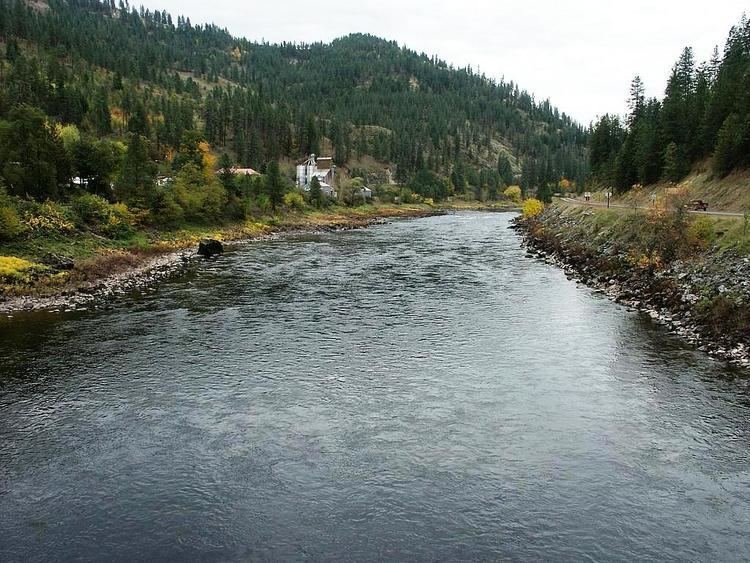- elevation 1,453 ft (443 m) Length 120 km Basin area 24,980 km² | - elevation 4,285 ft (1,306 m) Discharge 433.2 m³/s Country United States of America | |
 | ||
The Clearwater River is a 74.8-mile-long (120.4 km) river in north central Idaho, which flows westward from the Bitterroot Mountains along the Idaho-Montana border, and joins the Snake River at Lewiston. In October 1805, the Lewis and Clark Expedition descended the Clearwater River in dugout canoes, putting in at "Canoe Camp," five miles (8 km) downstream from Orofino.
Contents
Map of Clearwater River, Idaho, USA
By average discharge, the Clearwater River is the largest tributary of the Snake River. The River got its name for the Niimiipuutímt naming as Koos-Koos-Kai-Kai - “clear water”.
The drainage basin of the Clearwater River is 9,645 square miles (24,980 km2). Its mean annual discharge is 15,300 cubic feet per second (430 m3/s)
Course
At the small town of Kooskia, the Middle Fork and South Fork of the Clearwater River join their waters to form the main stem of the Clearwater. The larger Middle Fork is made up of the combined flows of the Lochsa and Selway rivers which flow from the Bitterroot Mountains located to the east, while the much smaller South Fork originates in the Selway-Bitterroot Wilderness to the south. From the confluence the Clearwater flows northwest, passing the Heart of the Monster site of the Nez Perce National Historical Park. U.S. Route 12 follows the river to Kamiah, where it is joined by Lawyer Creek.
The river then continues northwest through a canyon to the confluence with Lolo Creek. It soon passes the town of Greer and receives Jim Ford Creek from the right. At Orofino the river gains the waters of Orofino Creek and swings westward in a nearly straight line for about 3 miles (4.8 km), then receives the North Fork Clearwater River from the right at Ahsahka close to Dworshak Reservoir. After the North Fork contributes its flow, the Clearwater trends west and receives Big Canyon Creek from the left, and Bedrock Creek from the right.
As the river canyon cuts deeper into the Columbia Plateau, the Clearwater passes the unincorporated communities of Lenore, Myrtle, where it receives Cottonwood Creek from the left and then Arrow, where it receives the Potlatch River from the right. Lapwai Creek joins from the left where the river passes close to Spalding. Here, U.S. Highway 95 crosses the Clearwater while Highway 12 continues running along the north shore. The river soon widens and slows into the slack water of Lower Granite Lake as it approaches Lewiston. Just as it crosses the Idaho-Washington state line, it joins its waters with the Snake River.
Tributaries
The Clearwater breaks into several separate forks:
River modifications
The Dworshak Reservoir is the only major lake on the Clearwater system, created from the Dworshak Dam, completed in the early 1970s. Dworshak Dam is on the North Fork of the Clearwater River, and is just northwest of Orofino. There is no fish ladder; the dam blocks salmon and steelhead passage.
History
The border between Washington and Idaho was defined as the meridian running north from the confluence of the Clearwater River and the Snake River. Although this border is often referred to as the 117th meridian west longitude, the actual border line is slightly west (less than 2 miles) of the 117th meridian.
